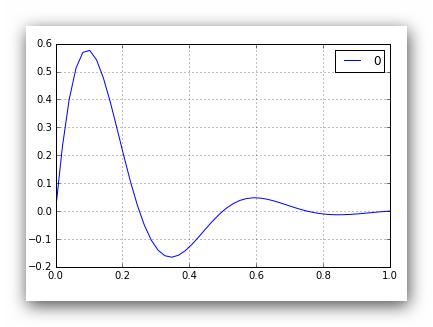python自學筆記15之例項之繪圖、dataframe操作、讀寫csv,excle
阿新 • • 發佈:2019-01-04
用Python繪圖,藉助強大的numpy和matplotlib
import numpy as np
import matplotlib.pyplot as plt
import pandas as pd
x = np.linspace(0,1)
y = np.sin(4*np.pi*x)*np.exp(-5*x)
t = pd.DataFrame(y,index = x)
t.plot()
plt.show()用pandas寫csv檔案
from matplotlib.finance import quotes_historical_yahoo
from datetime import 從工作目錄下可以看到多了個stockIBM.csv的檔案,需要注意的是:
MatplotlibDeprecationWarning: This function has been deprecated in 1.4 in favor of
, which maintains the original argument order, orquotes_historical_yahoo_ohlc, which uses the open-high-low-close order. This function will be removed in 1.5
mplDeprecation)
意味著從matplotlib.finance中匯入quotes_historical_yahool的時候出現了警告,
從matplotlib的官方幫助文件:這裡,可以看到:
This module is deprecated in 1.4 and will be moved to mpl_toolkits or it’s own project in the future.
matplotlib.finance模組在1.4中不支援有其他變動,其他更詳細的文件參看help
讀取csv:
result = pd.read_csv('stockIBM.csv')單獨一列的讀取顯示:
print(result['1'])
0 144.305395
1 137.217722
2 135.060600
3 136.495473
4 139.259276
5 139.394094
6 138.199971
7 132.816810
8 135.166530
9 135.243571
10 135.301350
11 134.839113
12 137.275500
13 136.370279
14 134.723651
...
238 156.990005
239 158.630005
240 158.899994
241 158.059998
242 157.669998
243 157.070007
244 156.839996
245 157.139999
246 156.710007
247 156.729996
248 154.970001
249 153.699997
250 154.470001
251 154.449997
252 150.020004
Name: 1, Length: 253, dtype: float64
注意不是索引是列名
建立一個DataFrame讀入singer.csv
from matplotlib.finance import quotes_historical_yahoo
from datetime import date
import pandas as pd
df = pd.DataFrame({'singer':['the rolling stones','beatless','guns n roses','metallica'],'song':['satisfaction','let it be','dont cry','nothing else matters']})
df.to_csv('singer.csv')
result = pd.read_csv('singer.csv')
print(result['singer'])
0 the rolling stones
1 beatless
2 guns n roses
3 metallica
Name: singer, dtype: object
dataframe簡單操作
列與列求和直接用+,賦值也是直接賦,千萬別想太多
data = {'number':[1001,1002,1003],'name':\
['xiaoming','xiaohong','xiaohua'],'python':\
[77,88,99],'math':[87,82,91]}
df = pd.DataFrame(data)
df['sum'] = df['python']+df['math']注意append的使用,dataframe.append是新增行
注意DataFrame的生成方式,裡面用了一個dict型別
讀寫excel
df.to_excel(‘grade.xlsx’)
pd.read_excel(‘grade.xlse’)
和csv類似
pandas官方文件:help

